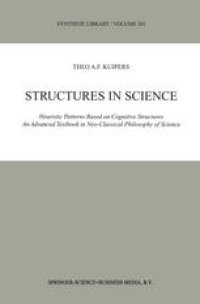
Ebook: Structures in Science: Heuristic Patterns Based on Cognitive Structures. An Advanced Textbook in Neo-Classical Philosophy of Science
Author: Theo A. F. Kuipers (auth.)
- Tags: Philosophy of Science, Interdisciplinary Studies, Artificial Intelligence (incl. Robotics), Logic
- Series: Synthese Library 301
- Year: 2001
- Publisher: Springer Netherlands
- Edition: 1
- Language: English
- pdf
Although there is an abundance of highly specialized monographs, learned collections and general introductions to the philosophy of science, only a few 25 years. synthetic monographs and advanced textbooks have appeared in the last The philosophy of science seems to have lost its self-confidence. The main reason for such a loss is that the traditional analytical, logical-empiricist approaches to the philosophy of science had to make a number of concessions, especially in response to the work of Popper, Kuhn and Lakatos. With Structures in Science I intend to present both a synthetic mono graph and an advanced textbook that accommodates and integrates the insight of these philosophers, in what I like to call a neo-classical approach. The resulting monograph elaborates several important topics from one or more perspectives, by distinguishing various kinds of research programs, and various ways of explaining and reducing laws and concepts, and by summarizing an integrated explication (presented in From Instrumentalism to Constructive Realism, ICR) of the notions of confirmation, empirical progress and truth approximation.
The philosophy of science has lost its self-confidence, witness the lack of advanced textbooks in contrast to the abundance of elementary textbooks. Structures in Science is an advanced textbook that explicates, updates, accommodates, and integrates the best insights of logical-empiricism and its main critics. This `neo-classical approach' aims at providing heuristic patterns for research.
The book introduces four ideal types of research programs (descriptive, explanatory, design, and explicative) and reanimates the distinction between observational laws and proper theories. It explicates various patterns of explanation by subsumption and specification as well as structures in reductive and other types of interlevel research. Its analysis of theory evaluation leads to new characterizations of confirmation, empirical progress, and pseudoscience. Partial analogies between progress in nomological research (i.e. observational, referential, and theoretical truth approximation, presented in detail in From Instrumentalism toConstructive Realism, 2000) and progress in explicative and design research emerge. Finally, special chapters are devoted to design research programs, computational philosophy of science, the structuralist approach to theories, and research ethics.
The philosophy of science has lost its self-confidence, witness the lack of advanced textbooks in contrast to the abundance of elementary textbooks. Structures in Science is an advanced textbook that explicates, updates, accommodates, and integrates the best insights of logical-empiricism and its main critics. This `neo-classical approach' aims at providing heuristic patterns for research.
The book introduces four ideal types of research programs (descriptive, explanatory, design, and explicative) and reanimates the distinction between observational laws and proper theories. It explicates various patterns of explanation by subsumption and specification as well as structures in reductive and other types of interlevel research. Its analysis of theory evaluation leads to new characterizations of confirmation, empirical progress, and pseudoscience. Partial analogies between progress in nomological research (i.e. observational, referential, and theoretical truth approximation, presented in detail in From Instrumentalism toConstructive Realism, 2000) and progress in explicative and design research emerge. Finally, special chapters are devoted to design research programs, computational philosophy of science, the structuralist approach to theories, and research ethics.
Content:
Front Matter....Pages i-xv
Front Matter....Pages 1-4
Research Programs and Research Strategies....Pages 5-35
Observational Laws and Proper Theories....Pages 37-69
Front Matter....Pages 71-73
Explanation and Reduction of Laws....Pages 75-96
Explanation and Description by Specification....Pages 97-130
Front Matter....Pages 131-134
Reduction and Correlation of Concepts....Pages 135-158
Levels, Styles, and Mind-Body Research....Pages 159-196
Front Matter....Pages 197-199
Testing and Further Separate Evaluation of Theories....Pages 201-228
Empirical Progress and Pseudoscience....Pages 229-250
Front Matter....Pages 251-254
Progress in Nomological, Explicative and Design Research....Pages 255-264
Design Research Programs....Pages 265-284
Front Matter....Pages 285-288
Computational Philosophy of Science....Pages 289-315
The Structuralist Aproach to Theories....Pages 317-341
‘Default-Norms’ in Research Ethics....Pages 343-356
Back Matter....Pages 357-413
The philosophy of science has lost its self-confidence, witness the lack of advanced textbooks in contrast to the abundance of elementary textbooks. Structures in Science is an advanced textbook that explicates, updates, accommodates, and integrates the best insights of logical-empiricism and its main critics. This `neo-classical approach' aims at providing heuristic patterns for research.
The book introduces four ideal types of research programs (descriptive, explanatory, design, and explicative) and reanimates the distinction between observational laws and proper theories. It explicates various patterns of explanation by subsumption and specification as well as structures in reductive and other types of interlevel research. Its analysis of theory evaluation leads to new characterizations of confirmation, empirical progress, and pseudoscience. Partial analogies between progress in nomological research (i.e. observational, referential, and theoretical truth approximation, presented in detail in From Instrumentalism toConstructive Realism, 2000) and progress in explicative and design research emerge. Finally, special chapters are devoted to design research programs, computational philosophy of science, the structuralist approach to theories, and research ethics.
Content:
Front Matter....Pages i-xv
Front Matter....Pages 1-4
Research Programs and Research Strategies....Pages 5-35
Observational Laws and Proper Theories....Pages 37-69
Front Matter....Pages 71-73
Explanation and Reduction of Laws....Pages 75-96
Explanation and Description by Specification....Pages 97-130
Front Matter....Pages 131-134
Reduction and Correlation of Concepts....Pages 135-158
Levels, Styles, and Mind-Body Research....Pages 159-196
Front Matter....Pages 197-199
Testing and Further Separate Evaluation of Theories....Pages 201-228
Empirical Progress and Pseudoscience....Pages 229-250
Front Matter....Pages 251-254
Progress in Nomological, Explicative and Design Research....Pages 255-264
Design Research Programs....Pages 265-284
Front Matter....Pages 285-288
Computational Philosophy of Science....Pages 289-315
The Structuralist Aproach to Theories....Pages 317-341
‘Default-Norms’ in Research Ethics....Pages 343-356
Back Matter....Pages 357-413
....